Things to Do This Week in NYC: Dec. 11 -18
Discover all the ways you can rediscover NYC!


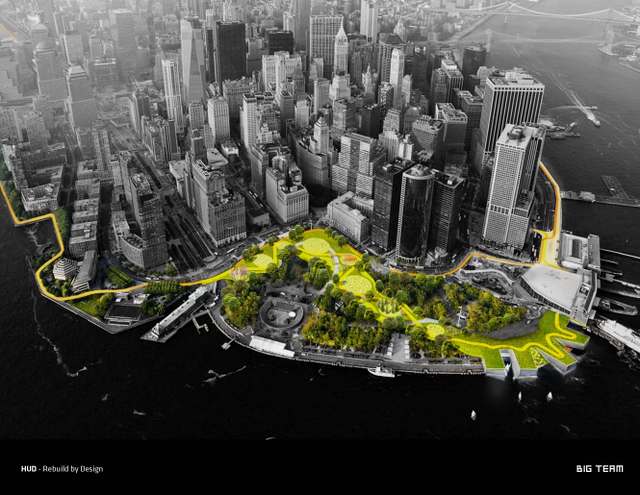
Rendering of The BIG U, “The Harbor Berm,” an elevated path through the park. Image Courtesy of BIG/ Rebuild By Design
Water has shaped civilizations and landscapes throughout history, and a city’s access to water often defines its destiny. From London to Mumbai and New York to Copenhagen, most of the coastal cities have experienced devastation from torrential downpours and rising sea levels. The approach taken in Copenhagen however, has championed holistic, integrated solutions and extensive public-private collaboration, making the city a global leader in fighting climate change while improving recreational infrastructure for its citizens.
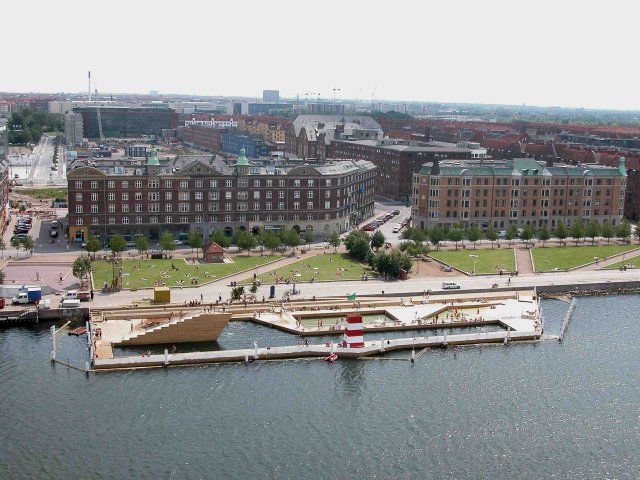
Aerial photo of Harbor Bath in Copenhagen. Image courtesy of BIG
To share this knowledge and experience in water management, The AIA New York Chapter in collaboration with the Consulate General of Denmark in New York, the Confederation of Danish Industry and State of Green, turned the spotlight on the water-related challenges in New York and Copenhagen.
The Panel discussion held at the Center for Architecture attracted nearly 400 people. Speakers included Tomas Rossant, AIANY president elect and Ambassador Jarl Frijs-Madsen, Consul General of Denmark in NY, Architect Bjarke Ingels, Founder of BIG and the City Architect of Copenhagen, Tina Saaby as well as key players from the public and private sectors in both Denmark and the US.
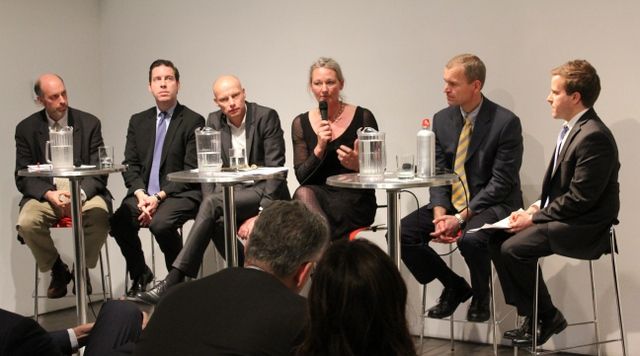
From L-R- Roland Lewis, Doug Friend, Henk Ovink, Tina Saaby, Jesper Kjelds, Alan Cohn. Image Courtesy of The Consulate General of Denmark in New York.
It’s no longer relevant to ask ‘if’ cities such as New York and Copenhagen are threatened by the effects of climate change. The question is not whether to act, but how to act. How do we increase the resiliency and sustainability of our coastal cities?
Hurricane Sandy and its aftermath left tens of thousands homeless, destroyed entire communities in coastal New York and New Jersey, crippled mass transit, cut power to more than 8 million homes and inflicted billions of dollars in infrastructure damage. Sandy was in many ways a defining moment in the history of New York City. For the first time, the resiliency of New York (and America) was seriously questioned.
The discussion moderated by Rick Bell, Executive Director, AIA NY, weaved in and out of various topics- from affordable housing to post industrial waterfronts. Tina Saaby and Bjarke Ingels discussed strategies on how the public and private sectors can join forces to make cities such as New York and Copenhagen more resilient while remaining vibrant and sustainable.According to Saaby, the most important factor that affects the livability of any city is having ambitious leadership with a bold vision to lead the city a hundred years into the future while making strategic short term planning decisions. Bjarke Ingels, recipient of the WSJ innovator of the year award, quickly pointed out how differences in cultures also affect planning in a city.
The Bloomberg administration rigorously expanded New York’s bike lanes and rolled out America’s largest bike sharing program, yet the city is far from having a world class biking infrastructure. Copenhagen, on the other hand, has always been a model in using the bicycle as an invaluable tool to restore the balance between transportation and sustainability to its urban fabric. Over the past 30 years, the city of Copenhagen has gradually removed car-parking, effectively clearing the way for bike infrastructure. (Not to forget the famous 180% tax on cars!)
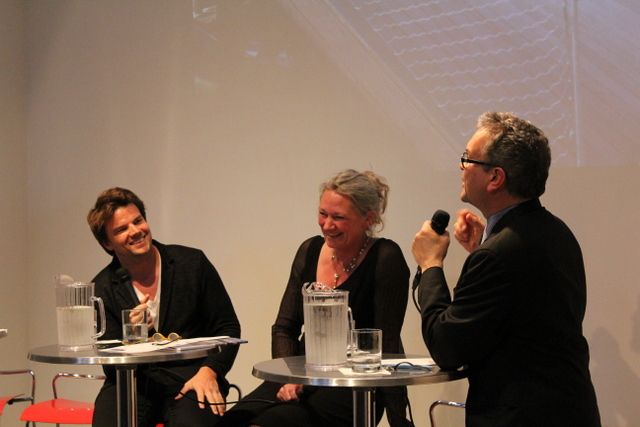
From L-R, Bjarke Ingels, Tina Saaby, Rick Bell. Image Courtesy of The Consulate General of Denmark in New York.
The concept of community living is another factor that differentiates Copenhagen from New York. Citing the example of his famed 8 house, located in a newly developed part of Copenhagen, Ingels explained the need for social encounters among residents as a catalyst for transforming the neighborhood into a lively community. The social norms in New York on the other hand often conflict with the desire to facilitate social encounters. Invisible boundaries create unspoken but established public and private spaces.
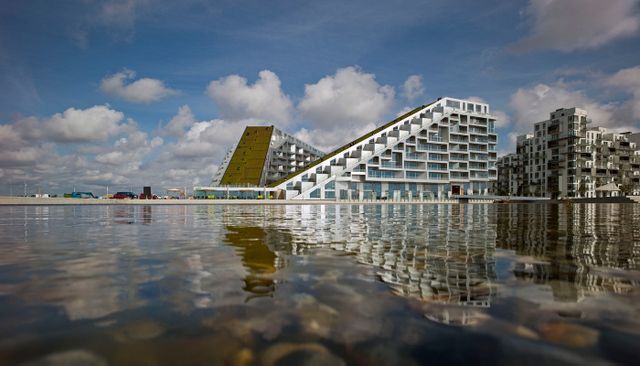
8 House, Image Courtesy of BIG
In the aftermath of hurricane Sandy, President Obama appointed Shaun Donovan to lead a task force whose objective was not just to rebuild but also to radically rethink the region’s infrastructure. While touring the Netherlands to get some valuable insights on the acclaimed Dutch water management techniques, Donovan not only learned about their innovations, but also forged a fruitful collaboration that would change the course in which New York was about to rebuild itself. Henk Ovink, recently photographed by the NY Times, standing waist high in water, metaphorically representing the future of many coastal cities, was soon stationed in the US as Donovan’s Chief Advisor by the Dutch Ministry of Infrastructure and the Environment.
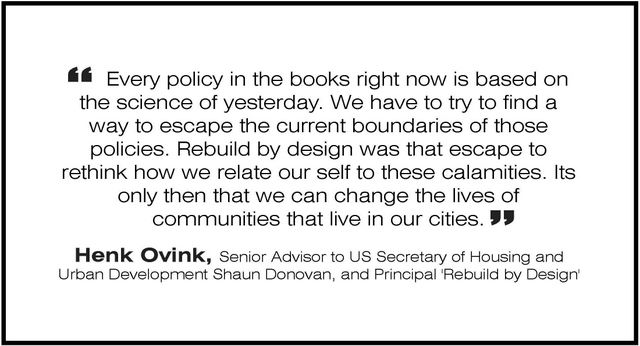
Rethinking the traditional American model for rebuilding, the focus soon shifted towards a more holistic and collaborative approach; thus was born Rebuild by Design—a comprehensive regional assessment and design competition.
The intention of the competition was to garner regionally-scalable but locally-contextual ideas rather than fantasist solutions, through a collaborative environment where designers, scientists, engineers, planners and economists work together with the government and—more importantly—local communities. What followed was a string of innovative tactics to create flood protection, livable communities, and economic opportunities through community-based collaborative design.
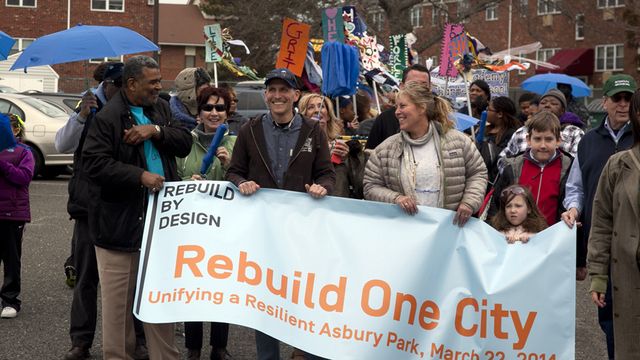
Image Courtesy of Rebuild by Design
In the discussion that followed, panelists explored the complexity of city making and how the integration of Urban Planning, infrastructure and new technologies is redefining our efforts to cope with climate change. Yes, climate change IS real and it has no political boundaries. As cities around the world grapple with water related calamities, Jesper Kjelds, Vice President, Danish Hydraulic Institute, pointed out that typically, “most places are reactive, there has to be a catastrophe and then things happen. We have to be better prepared for problems like droughts and floods and build resilient systems.”
Preparing for such events however, goes deeper than redesigning physical structures and ultimately must become a redesign of social and cultural values. Traditional approaches to mitigating water-related disasters is no longer a viable option. However, as Doug Friend, NY Regional Director, COWI Ocean and Coastal Consultants explained, “Engineers are realizing that we don’t need bulkheads, sea walls and levees only, local solutions vary from city to city and also from neighborhood to neighborhood. There is much more openness to solutions now that weren’t explored before.”
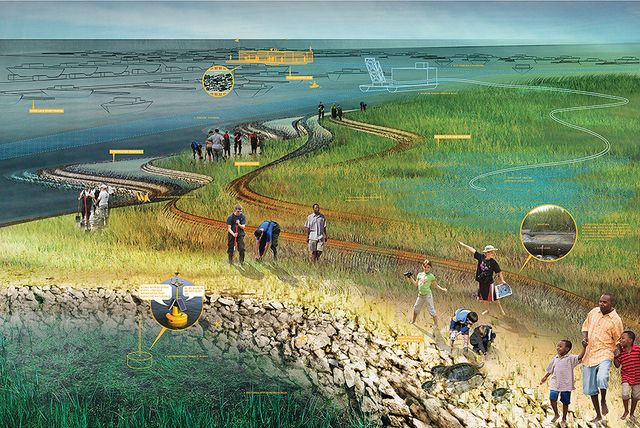
Remaking Jamaica Bay: A combination of green/blue strategies in the form of tiered, absorptive edges embedded with tidepools and bird/fish habitat structures. Image Courtesy of SCAPE / Landscape Architecture and Rebuild By Design
While resilient design strategies have become increasingly significant in the wake of Sandy, protecting our existing water infrastructure is vitally important to prepare for future storms. As more than half of New York’s treatment plants reside in the flood zone, DEP’s Director for Climate and Water Quality, Alan Cohn, stated, “We have to make sure that the investments we are making in our infrastructure today are viable in the next 50 years. Raising infrastructure above ground also offers opportunities to create amenities along the waterfront.”
Post-Bloomberg era New York has rediscovered its desire for the waterfront- now affectionately nicknamed ‘the sixth borough’ However, the radical transformation of the waterfront has also sparked interest among stakeholders whose varied agendas inhibit a unified approach to a resilient coastline. President and CEO of the Metropolitan Waterfront Alliance Roland Lewis explained, “We rely on the waterfront as a utility for resilience, for recreation, but that utility is governed by hundreds of stakeholders—from tug-boat operators to developers and government agencies. We need to bring together these stakeholders, experts (Architects, Planners, Landscape Architects) and the regulators to make the waterfront better for everyone. We need more rebuild by designs!”
While Sandy revealed major vulnerabilities across the region’s built environment, it also opened up opportunities for cities around the world to collaborate, blurring cultural and social boundaries in a global effort to mitigate the effects of climate change and develop resilient and sustainable cities.
Cities By Water: Solutions from Copehagen and New York – 4.8.14 from Center for Architecture on Vimeo.
bhushan is an Architect and Urban Designer at Perkins Eastman. Get in touch with him @Bhushan_NYC. This article was written in part by Catherine Mondkar.
Subscribe to our newsletter